- Dutch
- Frisian
- Saterfrisian
- Afrikaans
-
- Phonology
- Segment inventory
- Phonotactics
- Phonological processes
- Phonology-morphology interface
- Word stress
- Primary stress in simplex words
- Monomorphemic words
- Diachronic aspects
- Generalizations on stress placement
- Default penultimate stress
- Lexical stress
- The closed penult restriction
- Final closed syllables
- The diphthong restriction
- Superheavy syllables (SHS)
- The three-syllable window
- Segmental restrictions
- Phonetic correlates
- Stress shifts in loanwords
- Quantity-sensitivity
- Secondary stress
- Vowel reduction in unstressed syllables
- Stress in complex words
- Primary stress in simplex words
- Accent & intonation
- Clitics
- Spelling
- Morphology
- Word formation
- Compounding
- Nominal compounds
- Verbal compounds
- Adjectival compounds
- Affixoids
- Coordinative compounds
- Synthetic compounds
- Reduplicative compounds
- Phrase-based compounds
- Elative compounds
- Exocentric compounds
- Linking elements
- Separable complex verbs (SCVs)
- Gapping of complex words
- Particle verbs
- Copulative compounds
- Derivation
- Numerals
- Derivation: inputs and input restrictions
- The meaning of affixes
- Non-native morphology
- Cohering and non-cohering affixes
- Prefixation
- Suffixation
- Nominal suffixation: person nouns
- Conversion
- Pseudo-participles
- Bound forms
- Nouns
- Nominal prefixes
- Nominal suffixes
- -aal and -eel
- -aar
- -aard
- -aat
- -air
- -aris
- -ast
- Diminutives
- -dom
- -een
- -ees
- -el (nominal)
- -elaar
- -enis
- -er (nominal)
- -erd
- -erik
- -es
- -eur
- -euse
- ge...te
- -heid
- -iaan, -aan
- -ief
- -iek
- -ier
- -ier (French)
- -ière
- -iet
- -igheid
- -ij and allomorphs
- -ijn
- -in
- -ing
- -isme
- -ist
- -iteit
- -ling
- -oir
- -oot
- -rice
- -schap
- -schap (de)
- -schap (het)
- -sel
- -st
- -ster
- -t
- -tal
- -te
- -voud
- Verbs
- Adjectives
- Adverbs
- Univerbation
- Neo-classical word formation
- Construction-dependent morphology
- Morphological productivity
- Compounding
- Inflection
- Inflection and derivation
- Allomorphy
- The interface between phonology and morphology
- Word formation
- Syntax
- Preface and acknowledgements
- Verbs and Verb Phrases
- 1 Characterization and classification
- 2 Projection of verb phrases I:Argument structure
- 3 Projection of verb phrases II:Verb frame alternations
- Introduction
- 3.1. Main types
- 3.2. Alternations involving the external argument
- 3.3. Alternations of noun phrases and PPs
- 3.3.1. Dative/PP alternations (dative shift)
- 3.3.1.1. Dative alternation with aan-phrases (recipients)
- 3.3.1.2. Dative alternation with naar-phrases (goals)
- 3.3.1.3. Dative alternation with van-phrases (sources)
- 3.3.1.4. Dative alternation with bij-phrases (possessors)
- 3.3.1.5. Dative alternation with voor-phrases (benefactives)
- 3.3.1.6. Conclusion
- 3.3.1.7. Bibliographical notes
- 3.3.2. Accusative/PP alternations
- 3.3.3. Nominative/PP alternations
- 3.3.1. Dative/PP alternations (dative shift)
- 3.4. Some apparent cases of verb frame alternation
- 3.5. Bibliographical notes
- 4 Projection of verb phrases IIIa:Selection of clauses/verb phrases
- 5 Projection of verb phrases IIIb:Argument and complementive clauses
- Introduction
- 5.1. Finite argument clauses
- 5.2. Infinitival argument clauses
- 5.3. Complementive clauses
- 6 Projection of verb phrases IIIc:Complements of non-main verbs
- 7 Projection of verb phrases IIId:Verb clusters
- 8 Projection of verb phrases IV: Adverbial modification
- 9 Word order in the clause I:General introduction
- 10 Word order in the clause II:Position of the finite verb (verb-first/second)
- 11 Word order in the clause III:Clause-initial position (wh-movement)
- Introduction
- 11.1. The formation of V1- and V2-clauses
- 11.2. Clause-initial position remains (phonetically) empty
- 11.3. Clause-initial position is filled
- 12 Word order in the clause IV:Postverbal field (extraposition)
- 13 Word order in the clause V: Middle field (scrambling)
- 14 Main-clause external elements
- Nouns and Noun Phrases
- 1 Characterization and classification
- 2 Projection of noun phrases I: complementation
- Introduction
- 2.1. General observations
- 2.2. Prepositional and nominal complements
- 2.3. Clausal complements
- 2.4. Bibliographical notes
- 3 Projection of noun phrases II: modification
- Introduction
- 3.1. Restrictive and non-restrictive modifiers
- 3.2. Premodification
- 3.3. Postmodification
- 3.3.1. Adpositional phrases
- 3.3.2. Relative clauses
- 3.3.3. Infinitival clauses
- 3.3.4. A special case: clauses referring to a proposition
- 3.3.5. Adjectival phrases
- 3.3.6. Adverbial postmodification
- 3.4. Bibliographical notes
- 4 Projection of noun phrases III: binominal constructions
- Introduction
- 4.1. Binominal constructions without a preposition
- 4.2. Binominal constructions with a preposition
- 4.3. Bibliographical notes
- 5 Determiners: articles and pronouns
- Introduction
- 5.1. Articles
- 5.2. Pronouns
- 5.3. Bibliographical notes
- 6 Numerals and quantifiers
- 7 Pre-determiners
- Introduction
- 7.1. The universal quantifier al 'all' and its alternants
- 7.2. The pre-determiner heel 'all/whole'
- 7.3. A note on focus particles
- 7.4. Bibliographical notes
- 8 Syntactic uses of noun phrases
- Adjectives and Adjective Phrases
- 1 Characteristics and classification
- 2 Projection of adjective phrases I: Complementation
- 3 Projection of adjective phrases II: Modification
- 4 Projection of adjective phrases III: Comparison
- 5 Attributive use of the adjective phrase
- 6 Predicative use of the adjective phrase
- 7 The partitive genitive construction
- 8 Adverbial use of the adjective phrase
- 9 Participles and infinitives: their adjectival use
- 10 Special constructions
- Adpositions and adpositional phrases
- 1 Characteristics and classification
- Introduction
- 1.1. Characterization of the category adposition
- 1.2. A formal classification of adpositional phrases
- 1.3. A semantic classification of adpositional phrases
- 1.3.1. Spatial adpositions
- 1.3.2. Temporal adpositions
- 1.3.3. Non-spatial/temporal prepositions
- 1.4. Borderline cases
- 1.5. Bibliographical notes
- 2 Projection of adpositional phrases: Complementation
- 3 Projection of adpositional phrases: Modification
- 4 Syntactic uses of the adpositional phrase
- 5 R-pronominalization and R-words
- 1 Characteristics and classification
- Phonology
-
- General
- Phonology
- Segment inventory
- Phonotactics
- Phonological Processes
- Assimilation
- Vowel nasalization
- Syllabic sonorants
- Final devoicing
- Fake geminates
- Vowel hiatus resolution
- Vowel reduction introduction
- Schwa deletion
- Schwa insertion
- /r/-deletion
- d-insertion
- {s/z}-insertion
- t-deletion
- Intrusive stop formation
- Breaking
- Vowel shortening
- h-deletion
- Replacement of the glide w
- Word stress
- Clitics
- Allomorphy
- Orthography of Frisian
- Morphology
- Inflection
- Word formation
- Derivation
- Prefixation
- Infixation
- Suffixation
- Nominal suffixes
- Verbal suffixes
- Adjectival suffixes
- Adverbial suffixes
- Numeral suffixes
- Interjectional suffixes
- Onomastic suffixes
- Conversion
- Compositions
- Derivation
- Syntax
- Verbs and Verb Phrases
- Characteristics and classification
- Unergative and unaccusative subjects
- Evidentiality
- To-infinitival clauses
- Predication and noun incorporation
- Ellipsis
- Imperativus-pro-Infinitivo
- Expression of irrealis
- Embedded Verb Second
- Agreement
- Negation
- Nouns & Noun Phrases
- Classification
- Complementation
- Modification
- Partitive noun constructions
- Referential partitive constructions
- Partitive measure nouns
- Numeral partitive constructions
- Partitive question constructions
- Nominalised quantifiers
- Kind partitives
- Partitive predication with prepositions
- Bare nominal attributions
- Articles and names
- Pronouns
- Quantifiers and (pre)determiners
- Interrogative pronouns
- R-pronouns
- Syntactic uses
- Adjective Phrases
- Characteristics and classification
- Complementation
- Modification and degree quantification
- Comparison by degree
- Comparative
- Superlative
- Equative
- Attribution
- Agreement
- Attributive adjectives vs. prenominal elements
- Complex adjectives
- Noun ellipsis
- Co-occurring adjectives
- Predication
- Partitive adjective constructions
- Adverbial use
- Participles and infinitives
- Adposition Phrases
- Characteristics and classification
- Complementation
- Modification
- Intransitive adpositions
- Predication
- Preposition stranding
- Verbs and Verb Phrases
-
- General
- Morphology
- Morphology
- 1 Word formation
- 1.1 Compounding
- 1.1.1 Compounds and their heads
- 1.1.2 Special types of compounds
- 1.1.2.1 Affixoids
- 1.1.2.2 Coordinative compounds
- 1.1.2.3 Synthetic compounds and complex pseudo-participles
- 1.1.2.4 Reduplicative compounds
- 1.1.2.5 Phrase-based compounds
- 1.1.2.6 Elative compounds
- 1.1.2.7 Exocentric compounds
- 1.1.2.8 Linking elements
- 1.1.2.9 Separable Complex Verbs and Particle Verbs
- 1.1.2.10 Noun Incorporation Verbs
- 1.1.2.11 Gapping
- 1.2 Derivation
- 1.3 Minor patterns of word formation
- 1.1 Compounding
- 2 Inflection
- 1 Word formation
- Morphology
- Syntax
- Adjectives and adjective phrases (APs)
- 0 Introduction to the AP
- 1 Characteristics and classification of APs
- 2 Complementation of APs
- 3 Modification and degree quantification of APs
- 4 Comparison by comparative, superlative and equative
- 5 Attribution of APs
- 6 Predication of APs
- 7 The partitive adjective construction
- 8 Adverbial use of APs
- 9 Participles and infinitives as APs
- Nouns and Noun Phrases (NPs)
- 0 Introduction to the NP
- 1 Characteristics and Classification of NPs
- 2 Complementation of NPs
- 3 Modification of NPs
- 3.1 Modification of NP by Determiners and APs
- 3.2 Modification of NP by PP
- 3.3 Modification of NP by adverbial clauses
- 3.4 Modification of NP by possessors
- 3.5 Modification of NP by relative clauses
- 3.6 Modification of NP in a cleft construction
- 3.7 Free relative clauses and selected interrogative clauses
- 4 Partitive noun constructions and constructions related to them
- 4.1 The referential partitive construction
- 4.2 The partitive construction of abstract quantity
- 4.3 The numerical partitive construction
- 4.4 The partitive interrogative construction
- 4.5 Adjectival, nominal and nominalised partitive quantifiers
- 4.6 Kind partitives
- 4.7 Partitive predication with a preposition
- 4.8 Bare nominal attribution
- 5 Articles and names
- 6 Pronouns
- 7 Quantifiers, determiners and predeterminers
- 8 Interrogative pronouns
- 9 R-pronouns and the indefinite expletive
- 10 Syntactic functions of Noun Phrases
- Adpositions and Adpositional Phrases (PPs)
- 0 Introduction to the PP
- 1 Characteristics and classification of PPs
- 2 Complementation of PPs
- 3 Modification of PPs
- 4 Bare (intransitive) adpositions
- 5 Predication of PPs
- 6 Form and distribution of adpositions with respect to staticity and construction type
- 7 Adpositional complements and adverbials
- Verbs and Verb Phrases (VPs)
- 0 Introduction to the VP in Saterland Frisian
- 1 Characteristics and classification of verbs
- 2 Unergative and unaccusative subjects and the auxiliary of the perfect
- 3 Evidentiality in relation to perception and epistemicity
- 4 Types of to-infinitival constituents
- 5 Predication
- 5.1 The auxiliary of being and its selection restrictions
- 5.2 The auxiliary of going and its selection restrictions
- 5.3 The auxiliary of continuation and its selection restrictions
- 5.4 The auxiliary of coming and its selection restrictions
- 5.5 Modal auxiliaries and their selection restrictions
- 5.6 Auxiliaries of body posture and aspect and their selection restrictions
- 5.7 Transitive verbs of predication
- 5.8 The auxiliary of doing used as a semantically empty finite auxiliary
- 5.9 Supplementive predication
- 6 The verbal paradigm, irregularity and suppletion
- 7 Verb Second and the word order in main and embedded clauses
- 8 Various aspects of clause structure
- Adjectives and adjective phrases (APs)
-
- General
- Phonology
- Afrikaans phonology
- Segment inventory
- Overview of Afrikaans vowels
- The diphthongised long vowels /e/, /ø/ and /o/
- The unrounded mid-front vowel /ɛ/
- The unrounded low-central vowel /ɑ/
- The unrounded low-central vowel /a/
- The rounded mid-high back vowel /ɔ/
- The rounded high back vowel /u/
- The rounded and unrounded high front vowels /i/ and /y/
- The unrounded and rounded central vowels /ə/ and /œ/
- The diphthongs /əi/, /œy/ and /œu/
- Overview of Afrikaans consonants
- The bilabial plosives /p/ and /b/
- The alveolar plosives /t/ and /d/
- The velar plosives /k/ and /g/
- The bilabial nasal /m/
- The alveolar nasal /n/
- The velar nasal /ŋ/
- The trill /r/
- The lateral liquid /l/
- The alveolar fricative /s/
- The velar fricative /x/
- The labiodental fricatives /f/ and /v/
- The approximants /ɦ/, /j/ and /ʋ/
- Overview of Afrikaans vowels
- Word stress
- The phonetic properties of stress
- Primary stress on monomorphemic words in Afrikaans
- Background to primary stress in monomorphemes in Afrikaans
- Overview of the Main Stress Rule of Afrikaans
- The short vowels of Afrikaans
- Long vowels in monomorphemes
- Primary stress on diphthongs in monomorphemes
- Exceptions
- Stress shifts in place names
- Stress shift towards word-final position
- Stress pattern of reduplications
- Phonological processes
- Vowel related processes
- Consonant related processes
- Homorganic glide insertion
- Phonology-morphology interface
- Phonotactics
- Morphology
- Syntax
- Afrikaans syntax
- Nouns and noun phrases
- Characteristics of the NP
- Classification of nouns
- Complementation of NPs
- Modification of NPs
- Binominal and partitive constructions
- Referential partitive constructions
- Partitive measure nouns
- Numeral partitive constructions
- Partitive question constructions
- Partitive constructions with nominalised quantifiers
- Partitive predication with prepositions
- Binominal name constructions
- Binominal genitive constructions
- Bare nominal attribution
- Articles and names
- Pronouns
- Quantifiers, determiners and predeterminers
- Syntactic uses of the noun phrase
- Adjectives and adjective phrases
- Characteristics and classification of the AP
- Complementation of APs
- Modification and Degree Quantification of APs
- Comparison by comparative, superlative and equative degree
- Attribution of APs
- Predication of APs
- The partitive adjective construction
- Adverbial use of APs
- Participles and infinitives as adjectives
- Verbs and verb phrases
- Characterisation and classification
- Argument structure
- Verb frame alternations
- Complements of non-main verbs
- Verb clusters
- Complement clauses
- Adverbial modification
- Word order in the clause: Introduction
- Word order in the clause: position of the finite Verb
- Word order in the clause: Clause-initial position
- Word order in the clause: Extraposition and right-dislocation in the postverbal field
- Word order in the middle field
- Emphatic constructions
- Adpositions and adposition phrases
In this section an overview of the Afrikaans vowels, short and long, as well as the diphthongs, is provided. In the descriptions of the individual vowel segments detailed charts are provided.
The diagrams presented here (Figures 2 and 3), of the Standard Afrikaans vowels, have been constructed on the basis of real acoustic measurements made of productions in a phonetic context /s_s/, read in a word list style. The speaker, a prominent radio personality, is generally acknowledged to be a prototypical speaker of Standard Afrikaans. In a recent survey she was nominated as the most 'appropriate' speaker of Standard Afrikaans. Other participants (N = 344) in this survey were from all walks of life, male and female and of different ages and ethnicity groups.
In Figures 4 and 5 the same kind of measurements are provided for a coloured variety of Afrikaans, as spoken in Genadendal, Western Cape. This is due to its important standing in the historical evolution of Afrikaans. This variety is represented here, and in all other descriptions of the individual vowels elsewhere. Of course, there are many other varieties of coloured Afrikaans as well. The above-mentioned information is based on recordings of a number of young female speakers of Genadendal.
Vowels are customarily represented in a chart as in Figure 1, that is a slightly adapted version of the IPA vowel chart; the Afrikaans short vowels are placed in the eight main cardinal positions, including /ə/, /œ/, /ɛ/, /ɔ/ and /ɑ/ while /i/, /y/ and /u/ are also classified by most phoneticians and phonologists (e.g. Le Roux and Pienaar (1927), Wissing (2017), Wissing (2014), Coetzee (1982), Combrink and De Stadler (1987) and De Villiers and Ponelis (1987) as short. The long vowels of Afrikaans are /e/, /ø/ and /o/. The true diphthongs of Afrikaans are /əi/, /œy/ and /œu/. Vowels are, furthermore, classified according to their articulation, specifically with reference to the movement of the tongue and lips. Broadly speaking, the vowels and diphthongs of Afrikaans are characterised by a notably laxed articulatory basis. Schwa plays an important role in the case of the true diphthong /əi/, where it has /ə/ as a starting point in the articulatory movement of the tongue; this also applies to the final segment in the close-mid long vowels i.e. front /e/ and /ø/ as well as back /o/; all these long vowels show a strong tendency to have schwa as target (thus /e/ is realised as /iə/, /ø/ as /yœ/, and /o/ as /uə/). A notable consequence of such lax articulation is to be observed in the inclination towards derounding of the marked rounded vowels /y/, /ø/ and /œ/ to respectively /i/, /e/ and /ə/. In the speech-production of a large proportion of Afrikaans speakers this unrounding even leads to near-neutralisation of these marked rounded vowels with their unmarked pairs.
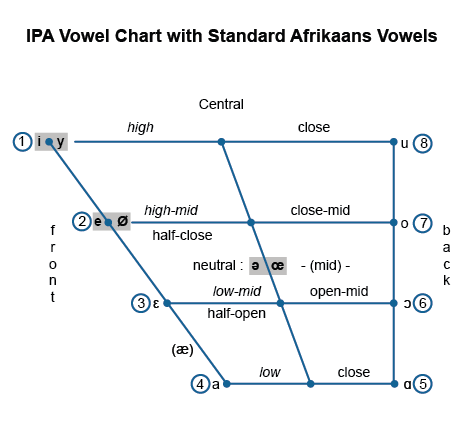
- Vowels are placed according to the IPA vowel chart
- Numbers 1 – 8 indicate the eight cardinal vowels; they are thus placed in their most extreme position; Afrikaans vowels generally show a far laxer and less extreme positioning
- The vowels on the right of the three shaded blocks are rounded counterparts of those on their left.
- The following alternate labels are used:
- According to the horizontal position of the tongue: front – central – back
- According to the vertical position of the tongue: high – mid-high – low - mid-low
- According to the relative openness of the mouth: close – close-mid – open-mid – open
Vowels are produced either with or without rounded lips throughout most of their articulation; we refer to vowels.
- The four pairs of vowel in grey blocks are marked and unmarked as to roundedness. The members on the left are unrounded; those on the right are rounded. Back vowels are per definition rounded.
- The long low, open vowel /a/ and the short front low /ɑ/; /a/ tends in some, particularly young speakers, to be even more back and slightly to definitely rounded (in which case it is transcribed as [ɒ]).
- The rounded vowels of Afrikaans are /y/, /u/, /ø/, /o/, /œ/ and /ɔ/, and the rounded diphthongs are /œu/ and /œy/. The rest are unrounded, viz. /i/, /e/, /a/, /ɑ/, /ɛ/ and /ə/ as well as the diphthong /əi/. Due to the special status of rounded vowels that have unrounded counterparts, they are also called marked rounded vowels; the unrounded ones are thus unmarked. Marked vowels are traditionally called 'normal round'; unmarked ones are called 'abnormal'.
Vowel segments are commonly described in terms of four features: roundedness, the vertical and horizontal dimensions of production in the mouth cavity, and duration. Here the focus is on the first three.
Rounded vowels are produced with rounded lips throughout most of their articulation; unrounded vowels have neutral or spread lips throughout most of their articulation. The monophthongal rounded vowels of Afrikaans are /y/, /u/, /ø/, /o/, /œ/ and /ɔ/; the rounded diphthongs are /œy/ and /œu/. The unrounded vowels include the monophthongal /i/, /e/, /a/, /ə/, /ɛ/ and /ɑ/; and the diphthong /əi/.
Afrikaans is often characterised by the underrounding of round vowels and round diphthongs; in many cases they may even be completely unrounded, sometimes leading to neutralisation.
Vowels are often subdivided according to the vertical dimension, that is, on the basis of the closeness of the tongue to the roof of the mouth (either the hard palate or the velum). Generally four levels of tongue height are recognised, viz. high, high-mid, low-mid and low. The high vowels of Afrikaans are /i/, /y/ and /u/. The high-mid vowels are /e/, /ø/, /o/. The /o/ vowel often shows a diphthongal character in most varieties of Afrikaans. While /ɛ/ and /ɔ/ are usually, as in Dutch, identified as low-mid, Afrikaans /ɛ/ is very often a high-mid vowel (see the acoustic vowel charts below). The low vowels are /a/ and /ɑ/.
Vowels are also described according to the horizontal dimension, that is, according to whether the tongue is relatively advanced, neutral or retracted in the mouth. Three or four levels of front-/backness are identified, depending on whether the central category is further subdivided into front-central and back-central. The front vowels of Afrikaans are /i/, /y/, /e/, /ø/, /ɛ/. The /y/ and /ø/ vowels, when clearly rounded, may then be characterised as front-central, as is the case in Dutch. The /e/ and /ø/ vowels mostly show a diphthongal character in most varieties of Afrikaans. The /ɑ/ vowel is front-central as well. The /a/ vowel is back-central, while /ɔ/, /o/ and /u/ are back vowels. The /u/ vowel is frequently centralised to a clear extent, in which case it has a back-central character.
Geographic and ethnic background, as well as age, and sometimes gender, all play important roles in the specific production of vowels, but especially that of /a/(Wissing 2006) and /u/(Wissing 2010).
In the following section the acoustic features of the vowel segments are dealt with.
In Figure 2 the acoustic vowel chart of the Standard Afrikaans (SAfr.) vowels is provided; the same is done in Figure 4 for coloured Afrikaans (CAfr.). Figure 3 and Figure 5 show the respective charts for the diphthongs and diphthongised vowel segments.
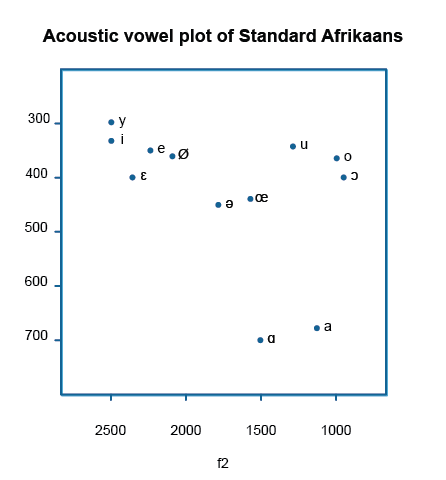
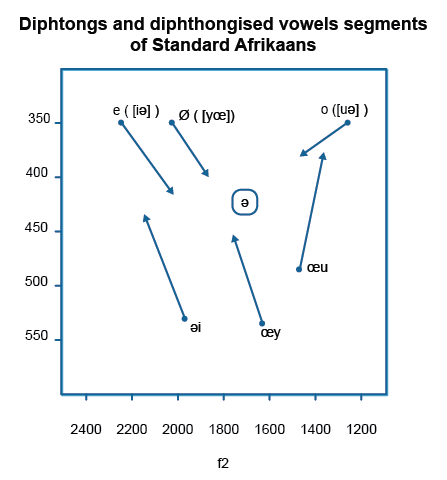
- Schwa /ə/ is added as a point of reference. Note that the three long vowels, /e/, /o/ and /ø/ all incline towards it.
- In the case of these three long vowels, the phonemic transcriptions, /e/, /o/ and /ø/, are complemented by their respective close phonetic transciptions in brackets.
- On the grounds of the lack of true monophthongal alternative productions of these thee long vowels, a case might be made for the acceptance of /iə/, /uə/ and /yœ/ as diphthongal phonemes instead of the currently unanimous use of /e/, /o/ and /ø/ as phonemes.
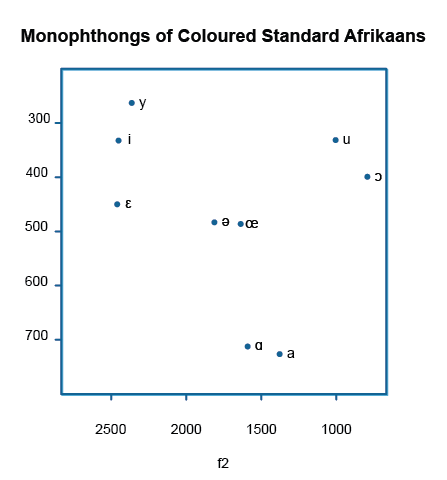
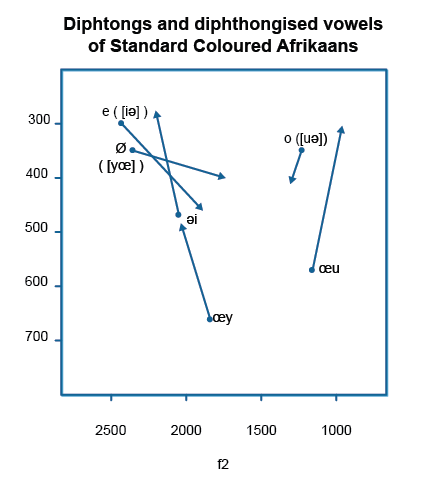
Basically the same tendency as to the direction of the arrows is found for Standard Afrikaans and coloured Afrikaans. This is in support of the claim that diphthongisation of the long mid-high vowels are a very common feature of the Afrikaans vowel system in general.
- 1982Fonetiek vir eerstejaars.Academica
- 1987Afrikaanse fonologie.Macmillan
- 1987Afrikaanse klankleer.Tafelberg
- 1927Afrikaanse fonetiek.Juta
- 2006Het jou mô en jou pô 'n strôndhuis by Hôrtenbos? Feit of fiksie?Southern African Linguistics and Applied Language Studies2487-100
- 2010Oor die status van die 'oe' in Afrikaans: 'n akoestiese analise.Tydskrif vir Geesteswetenskappe5031-49,
- 2014Fonetiek.Bundels
- 2017FonologieVan Schaik
